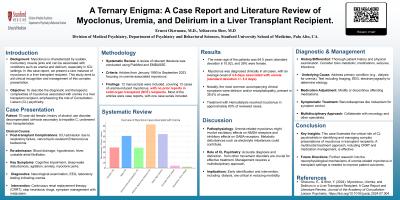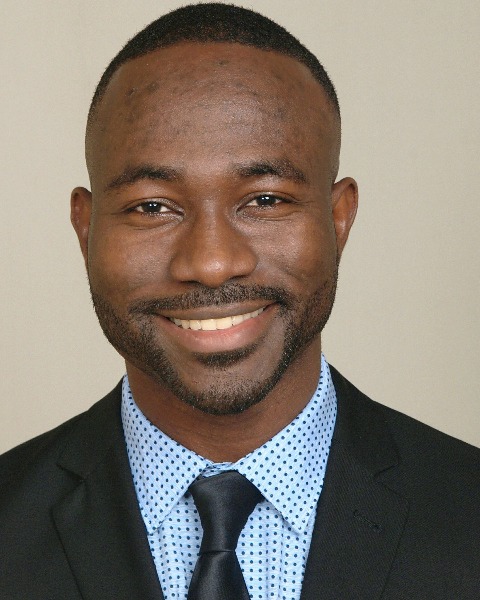Transplant Psychiatry and C-L Subspecialties
(206) A Ternary Enigma: A Case Report and Literature Review of Myoclonus, Uremia and Encephalopathy in a Liver Transplant Recipient


Ernest Okwuonu, MD
Consultation & Liaison Psychiatry Fellow
Department of Psychiatry/Stanford University School of Medicine
Pasadena, California
Yelizaveta Sher, MD, FACLP
Clinical Professor of Psychiatry
Stanford
Stanford, California
Presenting Author(s)
Co-Author(s)
Background
Consultation-liaison (CL) psychiatrists are frequently asked to consult on various abnormal movements. CL psychiatrists can be instrumental in aiding the primary teams in identifying and managing these movement disorders (Ghosal, 2022). Encephalopathy with myoclonus is an uncommon post-transplant complication, associated with increased morbidity and mortality. Its incidence is scarcely reported in solid organ transplant (SOT) recipients and its pathophysiology is not well understood.
Methods
We present a case of myoclonus associated with encephalopathy and uremia in a liver transplant recipient. We systematically review all published cases of uremia-induced myoclonus or associated etiologies of myoclonus in the ICU, inclusive of transplant recipients. We followed the guidelines and criteria set by the Preferred Reporting Items for Systematic Reviews and Meta-Analyses Group (PRISMA), version 2020. We queried EMBASSE and PubMed regarding applicable articles published in English from January 1, 1990, to September 30, 2023, using a combination of search terms in combinations of the following: “myoclonus” AND “uremia” AND “encephalopathy” OR “delirium” OR “transplant.” Duplicate records were excluded using Covidence. Titles were reviewed for relevance, and irrelevant or non-English titles were excluded.
Results
Our review produced 12 articles (case reports and series) yielding 13 cases of myoclonus associated with uremia, none reported in SOT recipients. The average age of the patients was 64.5 years (SD ±10.92) and 39% were female. Myoclonus's average onset time in the uremia setting was 4.6 days (standard deviation of 3.2 days). Of note, the most common accompanying clinical symptoms were delirium/encephalopathy (38.5%).
Discussion
The incidence and prevalence of movement disorders among solid organ transplant (SOT) recipients, including myoclonus, are not well documented. Several factors, such as the type of organ transplant, immunosuppressive medications, infections, and metabolic disturbances (e.g, uremia), can contribute to the occurrence of myoclonus and other movement disorders in SOT recipients (Anghel, 2013). Movement disorders in patients with renal dysfunction are hypothesized to emerge from complex processes involving the nervous and renal systems (Bhomwick et al, 2020). The results from the systematic review illustrate an average onset of myoclonus as 4.6 days in the setting of uremia. The speculative pathophysiology involves the accumulation of creatinine, guanidine, and its substrates in the brain, which have an excitatory effect on N‐methyl‐d‐aspartate receptors and an inhibitory effect on gamma-aminobutyric acid receptors, resulting in increased neuronal excitability (Rani, 2021).
Conclusion
Myoclonus can be misdiagnosed in the ICU, while CL psychiatrists are not infrequently consulted for movement disorders in the ICU, including myoclonus. Thus, it is important to be able to correctly diagnose it and appreciate contributing etiologies. Management involves treating the underlying disorder, such as CRRT for uremia, and utilizing benzodiazepines, alleviating physical burden and psychological distress.
References
1. Ghosal MK, et al. Assessment of Psychiatric Disorders in Consultation-Liaison Setting. Indian J Psychiatry. 2022.
2. Anghel D, et al. Neurotoxicity of immunosuppressive therapies in organ transplantation. Maedica (Bucur). 2013;8(2):170-5.
3. Bhowmick SS et al. Movement Disorders and Renal Diseases. Movement Disorders Clinical Practice. 2020;7(7):763-79.
4. Rani P, et al. Reversible Facial Myoclonus in Uremia. Movement Disorders Clinical Practice. 2021;8(1):133-4.
Presentation Eligibility: Not previously published or presented
Diversity, Equity, and Inclusion: By emphasizing the role of the CL psychiatrist in providing diagnostic clarity and optimizing management, the manuscript promotes the value of mental health professionals in diverse healthcare settings. This recognition contributes to a more inclusive healthcare system prioritizing holistic patient care. This approach values the expertise of different healthcare professionals, promoting inclusivity and respect for diverse perspectives in patient care.

